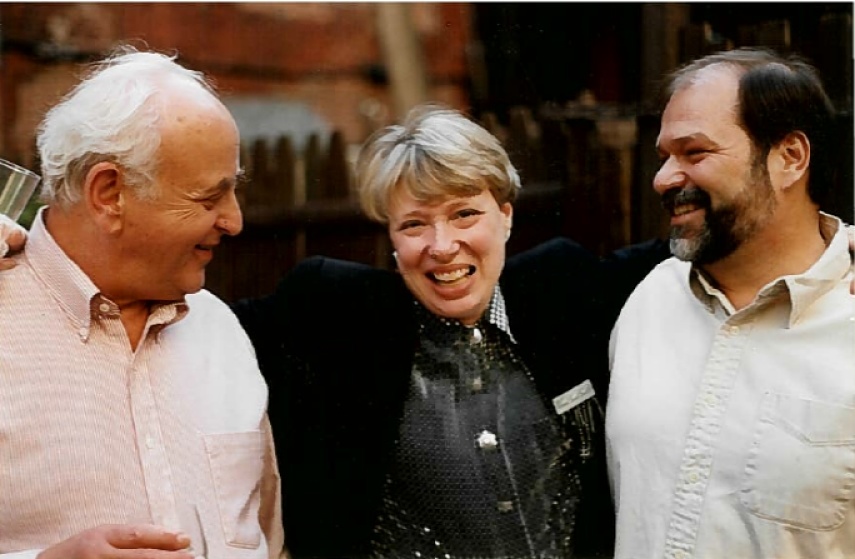NEW YORK CITY: Jim O’Quinn, the founding editor-in-chief of American Theatre, has announced he will leave the post in August. Hired by Theatre Communications Group in 1982 to edit what was then its newsletter, Theatre Communications, O’Quinn launched the monthly magazine American Theatre in April, 1984. A national search for his replacement has begun.

“I’m clearly retiring from this job of a lifetime, but by no means am I retiring from the theatre field,” said O’Quinn. “I expect to be writing regularly, probably more regularly than I’ve been able to in the past, for American Theatre, and to continue working with writers and artists across the country and around the world.”
TCG publisher Terry Nemeth, who has worked with O’Quinn almost since the beginning, said in a letter to the staff, “[Jim] has been an unselfish collaborator, wise sounding board and loyal friend to many of us at TCG both past and present…The theatre in all its many forms, both at home and abroad, has not seen a more eloquent champion than Jim.”
Teresa Eyring, TCG’s executive director, said, “It is a testament to Jim’s talent and tenacity that our field has a three-decade-old, nationally and globally distributed magazine, illuminating the work of our theatres and artists. With the new online version of AT joining the print version, he leaves the magazine well-positioned for ever increasing value and success.”
By the time he leaves the job, O’Quinn will have served as editor-in–chief for 313 issues of American Theatre magazine. He was instrumental in developing the Jerome Foundation Writers Fellowships, which nurtured dozens of early-career arts writers. His work at American Theatre was recognized with two National Magazine Awards for Editorial Excellence (2001, 2002) and an Excellence in Editing Award for Sustained Achievement from the Association of Theatre in Higher Education (2010).
In addition to American Theatre, O’Quinn’s articles and reviews have also appeared in Stagebill, Theatre Heute, Tatler, High Performance, The Drama Review and other publications, and he has covered U.S. and Canadian theatre for Encyclopedia Britannica’s Book of the Year since 2002. He edited The American Theatre Reader: Essays and Conversations from American Theatre Magazine, a compendium of the magazine’s most important writings, published in 2009 by TCG.
He also edited The Journal, a quarterly publication of the SDC Foundation, for six years. Early in his journalistic career, he won six Louisiana Press Association awards as publisher of a small-town weekly, The DeQuincy Journal.
In theatre, O’Quinn is the author and composer of a children’s opera, The Littlest Emperor, which was produced at the Contemporary Arts Center of New Orleans in 1978, and was music arranger for a series of acclaimed children’s theatre productions at Le Petit Theatre du Vieux Carré.
A Louisiana native, O’Quinn will move full-time to a house in New Orleans with his partner of more than 25 years, Richard Fumosa, and their dog Lucy.
Six years ago, in 2009, to commemorate the magazine’s 25th anniversary, O’Quinn gave an interview on the subject to TDF.org. His interlocuter was Rob Weinert-Kendt, who now serves as AT‘s senior editor. The Q&A is republished below.
For 25 years, Jim O’Quinn has turned his love for the stage into America’s leading theatre magazine.
TDF Stages, Apr. 23, 2009
Today’s theatre artists and audiences may take for granted that first-class professional theatre happens in every major city in America, not only in New York. And they may take for granted that there’s a top-flight magazine, American Theatre, to reflect and encourage that national theatre activity.
But neither were ever thus: It was not until the mid-1960s that what would soon be called the “regional theatre movement” began to take root in cities from Costa Mesa, Calif., to Hartford, Conn. Around that same time, Theatre Arts magazine—a longtime New York-based bastion of the commercial theatre scene—folded up shop. So while theatre began to boom to an unprecedented degree across the United States, there was no national publication on the beat.

That changed in 1984, when Theatre Communications Group—a membership organization comprising America’s nonprofit theatre companies, led at the time by legendary executive director Peter Zeisler and his associate Lindy Zesch—launched a new magazine with its mission and coverage area stated boldly in its title: American Theatre. To man the ship, TCG hired Louisiana-bred newspaperman Jim O’Quinn as its founding editor-in-chief. O’Quinn, despite his journalistic pedigree, happened also to be an inveterate theatre junkie, and had in fact come to New York to “legitimize” his infatuation with the stage by enrolling in the graduate performance studies department at New York University’s Tisch School of the Arts.
O’Quinn joined TCG and has been at the helm of the monthly publication ever since, covering the rise and rise, and the occasional fall, of American theatre’s fortunes with reliably incisive and searching features, interviews, reports, essays and think pieces.
O’Quinn sat down recently on the occasion of American Theatre’s 25th anniversary to talk about its genesis, its development and its relationship to the world it covers.
Q: How did you and American Theatre find each other?
Jim O’Quinn: I started out as a city desk reporter in New Orleans, back before Watergate, when you could actually graduate with a degree in journalism and then go to work in it. But I also worked in the theatre, including professionally at the short-lived Repertory Theatre of New Orleans, and I finally came up East in 1978 to legitimize that longstanding interest. I was pursuing my doctorate in performance studies at NYU when TCG hired me—as soon as I saw it advertised that they were looking for someone to edit their publications and to start a national magazine, I knew that was a job that had my name all over it. My task was to convince them that I was the one.
How was the magazine’s original editorial mandate defined?
It’s a complicated situation, in a way: You’ve got a magazine published by a membership organization for theatres, so in a certain way the theatres pay your salary. So how journalistically independent can you be? We determined from the first that American Theatre wasn’t going to be a newsletter or a house organ—happily, TCG wanted the same thing I wanted, a real live magazine with a journalistically impartial view of the field. It’s debatable what kind of a balance we’ve struck over the years, but I think, personally, that it’s been quite good. Let’s face it: In the concept of this magazine, theatre itself is a good thing; the difficulty comes when you try to address challenging issues facing the field. How do you talk, for example, about failures and difficulties?
Another challenge is keeping your eye on a sprawling national scene. How do you do that?
We work with freelance correspondents across the country, and really attempt in our planning for every issue to have geographical balance, balance between large and small theatres, balance in terms of diversity of all sorts—not only racial and gender diversity but in kinds of theatre: avant-garde versus traditional, contemporary versus classic work, and so on. All these kinds of balance are things we aim for in the long run as well as issue by issue.
I’m sure you’re sometimes asked why the magazine is not more New York- and Broadway-focused.
Commercial theatre is not central to the purview of American Theatre; we’re officially the journal for the nonprofit professional theatre in America. But I call it OBT—it’s “One Big Theatre,” really. It’s all interconnected. The lines are increasingly blurred, and that very blurring is one of the subjects we’ve often addressed. So I don’t get invited to the Tonys, but I don’t care. (Laughs)
One thing readers won’t find in American Theatre is play reviews. Why is that?
There’s no real point. We’re a monthly, in the first place, so we wouldn’t be timely. In the second place, we feel that reviewing is taken care of by publications in cities and communities across the country, and that our member theatres don’t need us piling onto them after their local reviewers have done so already. We do have something called Critic’s Notebook, where theatre critics write in depth about productions of significance or of particular accomplishment. We’ve tried in recent years to do that in such a way that the production is still available in some form, whether it’s a coproduction or a tour, so we won’t be writing, in essence, “Here’s this wonderful thing that happened; we saw it and you can’t.”
What are some of the biggest changes you’ve seen in the 25 years you’ve been covering American theatre?
Well, the field is stronger than ever in terms of numbers and influence. The estimates are that there are something like 1,900 not-for-profit theatres in America today. That’s incredible. When TCG started, there were 15 or so! Young people coming into the theatre today just assume that it was always that way—that there were always theatres everywhere, and people could make their living in Detroit or Minneapolis, but of course it wasn’t that way. You used to have to come to New York. Theatre was centrifugal; it started in New York and spun out all the way across the country. Now it’s centripetal—it comes to New York from creative outposts all over the place. That’s a huge difference.
Apart from American theatre, you’ve covered a lot of international theatre as well.
That’s something I’m proud of. In the late ’80s and early 90s, before the xenophobia of the Bush years, we introduced a lot of important international theatremakers to the United States. We had the first articles about Dario Fo that ever appeared in this country; we introduced Ariane Mnouchkine, Tadashi Suzuki, Robert Lepage. All these major figures in world theatre were introduced to America through American Theatre before they ever came here.
Being a monthly, you stay a bit above the opening-night fray. How, then, would define the role your magazine plays in the theatre scene?
The act of theatre happens between artists and audience, but it’s not complete with just that transaction. Because theatre is an art form of language and ideas, the discourse that follows the act of theatre is an integral part of it, and that’s where I think a magazine like American Theatre comes in. When you have a community that has good theatre but has lousy theatre critics, for example—if the discourse that derives from theatre is weak or faulty—then that weakens the art form itself. So I feel like this is a very important component of the act of theatre—to have a place for discussion, a forum, is essential.

